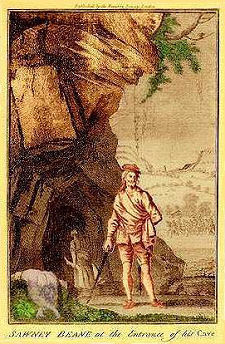 Edinburgh, Where the Bean Family Were Executed |
Alexander "Sawney" Bean lived from some time in the late 1300s to around 1430. Or, quite possibly, he never lived at all, and is just a creation of Scottish myth and folklore. But his story is persistent and widely accepted, so for the purposes of this page we'll suspend disbelief and assume he was a real person. The wider picture in Scotland at the time is set out in our Historical Timeline.
Alexander Bean (or, in some accounts, "Beane") was born in East Lothian in the latter half of the 1300s, the son of an agricultural labourer. In about 1400 Bean was forced to flee his home after forming a relationship with a woman known as Black Agnes Douglas and widely believed to be a witch.
Alexander and Agnes made their way across southern Scotland as outlaws, eventually finding and settling in a cave at Bennane Head, on what is now the South Ayrshire coast near Ballantrae. The entrance to the cave was cut off by the sea at high tide, and this is said to have helped them evade discovery for 25 years.
To begin with, they made a living by robbing and murdering passing travellers, storing their victims' more easily tracable valuables, and using the cash they raised this way to provide life's essentials. But this lifestyle became more difficult to sustain unnoticed as the Bean family grew. Alexander and Agnes are said to have produced 8 sons and 6 daughters, who in turn are said to have incestuously produced 18 grandsons and 14 granddaughters.
The Beans came up with a simple solution to the problem of feeding their rapidly growing family. Rather than just robbing and murdering their victims, they took to eating them as well, pickling anything not immediately consumed for later use.
But in about 1430 the Beans ambushed a man who was able to fight them off until other travellers on the road could come to his aid. Until then there had been no living witness to the existence of the family, but once it became clear that the disappearances in the area were the responsibility of a group of savage outlaws, forces were gathered to hunt them down.
It is said that King James I personally led the hunt for the Beans (the only fact that really allows any part of the story to be dated). Hundreds of men with dogs scoured every inch of the surrounding countryside, eventually discovering the cave at Bennane Head, complete with its evidence of mass murder and cannibalism. The Bean family were taken in chains to Edinburgh. Here, after the briefest of judicial processes, all the male members of the family were executed by having their hands and feet chopped off and being allowed to bleed to death, while the female members of the family were burned at the stake.
Truth or fiction? Well there is a marked lack of real historical evidence for a story which, if true, would have involved the disappearance of thousands of people over a prolonged period of time, and which ended with a manhunt led personally by the King, plus the mass execution of the men, women and children of the Bean family.
Probably fiction, then, and not the only story of its sort to come from Scotland's distant past. A very similar story allegedly from the mid 1300s concerns a certain Christie Cleek, by profession a butcher from Perth. Christie was said to be the leader of a group of brigands in the Grampians during the period around 1340 who took to attacking travellers, who they would rob and eat (together with their horses). It's been suggested that the stories of Sawney Bean and Christie Cleek might have a common origin, or, in the way of a modern urban myth, that they simply represent the retelling of the same story in a context that is more relevant for the particular audience at the time. But however dubious the story of Sawney Bean, his presence does add to the atmosphere of that part of the South Ayrshire coast, and the story of his family's demise is an accepted feature of the grislier end of Edinburgh's tourist industry today.

